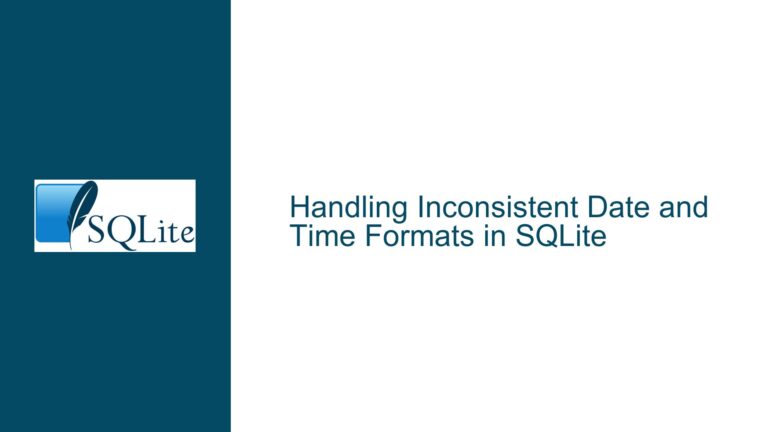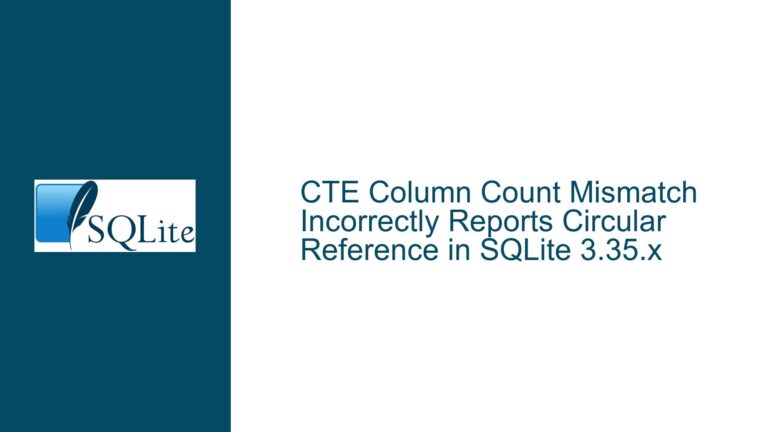Unexpected SELECT Output in WITHOUT ROWID Table Due to Unordered Columns
Issue Overview: SELECT Statement Returns Unexpected Row in WITHOUT ROWID Table
The core issue revolves around a SELECT query on a WITHOUT ROWID table in SQLite, which returns a row despite the query conditions seemingly not being met. The table in question, v0, is defined with an INTEGER PRIMARY KEY column v1 and an additional column v2 added via an ALTER TABLE statement. The query attempts to filter rows based on a combination of conditions involving v1 and v2. Specifically, the query is:
SELECT * FROM v0 WHERE (v1 = 20) OR (v1 = 10 AND v2 = 10);
Given that v2 is NULL (or empty) for the inserted row, the expectation is that the query should return no rows. However, the query unexpectedly returns the row 10|, indicating that the condition (v1 = 10 AND v2 = 10) is being evaluated incorrectly. This behavior is counterintuitive and points to a deeper issue in how SQLite handles WITHOUT ROWID tables and their associated index structures.
The root cause lies in the way SQLite internally implements WITHOUT ROWID tables. Unlike standard tables, which use a rowid-based b-tree for storage, WITHOUT ROWID tables use an index-btree where the primary key columns are ordered, but any additional columns appended to the index-btree are unordered. This distinction is critical because it affects how the query planner decides to use these columns for search operations. In this case, the query planner incorrectly attempted to use the unordered column v2 as part of the search condition, leading to the unexpected result.
Possible Causes: Misuse of Unordered Columns in WITHOUT ROWID Index-Btree
The unexpected behavior can be attributed to the following key factors:
Implementation of WITHOUT ROWID Tables:
In SQLite,WITHOUT ROWIDtables are implemented using an index-btree where the primary key columns are ordered, but any additional columns (those not part of the primary key) are appended to the index-btree in an unordered manner. This design choice is intentional to optimize storage and performance for certain use cases. However, it introduces a subtle edge case where the query planner might incorrectly assume that all columns in the index-btree are ordered and can be used for search optimizations.Query Planner Misinterpretation:
The query planner, when generating the execution plan for theSELECTstatement, incorrectly assumed that thev2column could be used to narrow down the search. This assumption is valid for standard tables and most index-btrees, where all columns are ordered. However, in the case ofWITHOUT ROWIDtables, thev2column is unordered, and using it as part of the search condition leads to incorrect results. The query planner generated a search condition that includedv2, as evidenced by theEXPLAIN QUERY PLANoutput:SEARCH v0 USING PRIMARY KEY (v1=? AND v2=?)This indicates that the planner attempted to use both
v1andv2for the search, which is invalid forWITHOUT ROWIDtables.Rare Edge Case in Code Generator:
The issue is a rare edge case in the SQLite code generator, which is responsible for translating SQL queries into executable bytecode. The code generator failed to account for the unique structure ofWITHOUT ROWIDtables when generating the search conditions. This oversight resulted in the inclusion of unordered columns in the search, leading to the unexpected output.Impact of ALTER TABLE on WITHOUT ROWID Tables:
TheALTER TABLEstatement used to add thev2column further complicates the issue. When a column is added to aWITHOUT ROWIDtable, it is appended to the index-btree in an unordered manner. This behavior is consistent with the design ofWITHOUT ROWIDtables but introduces potential pitfalls for queries that reference these unordered columns. The query planner must be explicitly aware of this limitation to avoid generating incorrect search conditions.
Troubleshooting Steps, Solutions & Fixes: Correcting Query Planner Behavior for WITHOUT ROWID Tables
To address the issue and prevent similar problems in the future, the following steps and solutions can be applied:
Upgrade to a Fixed Version of SQLite:
The issue has been resolved in SQLite version 3.36.0 (2021-06-18) and later, specifically through the check-in c21bc5a2353e660f. Upgrading to this version or later ensures that the query planner correctly handlesWITHOUT ROWIDtables and avoids using unordered columns in search conditions. The fix modifies the query planner to recognize the unique structure ofWITHOUT ROWIDtables and generate appropriate search conditions. After the fix, theEXPLAIN QUERY PLANoutput correctly shows:SEARCH v0 USING PRIMARY KEY (v1=?)This indicates that only the primary key column
v1is used for the search, as intended.Review and Modify Query Logic:
If upgrading SQLite is not immediately feasible, the query logic can be modified to avoid relying on unordered columns inWITHOUT ROWIDtables. For example, the original query:SELECT * FROM v0 WHERE (v1 = 20) OR (v1 = 10 AND v2 = 10);can be rewritten to explicitly handle the unordered column
v2in a way that aligns with the table’s structure. One approach is to split the query into two parts and combine the results usingUNION:SELECT * FROM v0 WHERE v1 = 20 UNION SELECT * FROM v0 WHERE v1 = 10 AND v2 = 10;This approach ensures that the query planner generates separate search conditions for each part of the query, avoiding the misuse of unordered columns.
Use EXPLAIN QUERY PLAN for Debugging:
TheEXPLAIN QUERY PLANstatement is a powerful tool for diagnosing issues related to query execution. By running:EXPLAIN QUERY PLAN SELECT * FROM v0 WHERE (v1 = 20) OR (v1 = 10 AND v2 = 10);developers can inspect the generated search conditions and identify any misuse of unordered columns. If the output includes unordered columns in the search condition, it indicates that the query planner is not handling the
WITHOUT ROWIDtable correctly. This information can guide further troubleshooting and query optimization.Avoid Unordered Columns in Critical Queries:
When designing schemas and queries forWITHOUT ROWIDtables, it is important to be aware of the limitations imposed by unordered columns. Avoid using unordered columns in critical search conditions, especially when precise filtering is required. Instead, consider restructuring the table or query to rely only on ordered columns (i.e., primary key columns) for search operations.Monitor for Similar Issues in Other Lightweight Databases:
While this issue is specific to SQLite’s implementation ofWITHOUT ROWIDtables, similar problems can arise in other lightweight databases that use specialized storage structures. Developers working with such databases should be vigilant about understanding the internal implementation details and how they impact query behavior. Regularly reviewing documentation and release notes can help identify and address potential issues early.
By following these steps and solutions, developers can effectively troubleshoot and resolve issues related to WITHOUT ROWID tables in SQLite, ensuring correct and efficient query execution. The key takeaway is to understand the unique characteristics of WITHOUT ROWID tables and design queries that align with their underlying structure.






